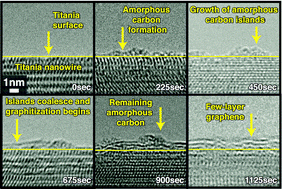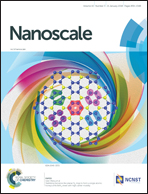Catalytic synthesis of few-layer graphene on titania nanowires†
Abstract
Growth mechanisms of graphitic nanostructures on metal oxides by chemical vapor deposition (CVD) are observed at 750 °C, using titania nanowire aerogel (NWAG) as a three-dimensional substrate and without metal catalysts. We temporally observed catalytic transformation of amorphous carbon into few-layer graphene on the surface of 5–10 nm diameter titania nanowires. The graphitization spontaneously terminates when the titania nanowires are encapsulated by a shell of approximately three graphene layers. Extended CVD time beyond the termination point (>1125 seconds) yields only additional amorphous carbon deposits on top of the few-layer graphene. Furthermore, it was discovered that the islands of amorphous carbon do not graphitize unless they catalytically grow beyond a threshold size of 5–7 nm along the nanowire length, even after an extended thermal treatment. The electrical conductivity of the NWAG increased by four orders of magnitude, indicating that the graphene shell mediated by titania nanowires yielded a network of graphene throughout the three-dimensional nanostructure of the aerogel. Our results help us understand the growth mechanisms of few-layer graphene on nanostructured metal oxides, and inspire facile and controllable processing of metal oxide–nanocarbon fiber–shell composites.



 Please wait while we load your content...
Please wait while we load your content...